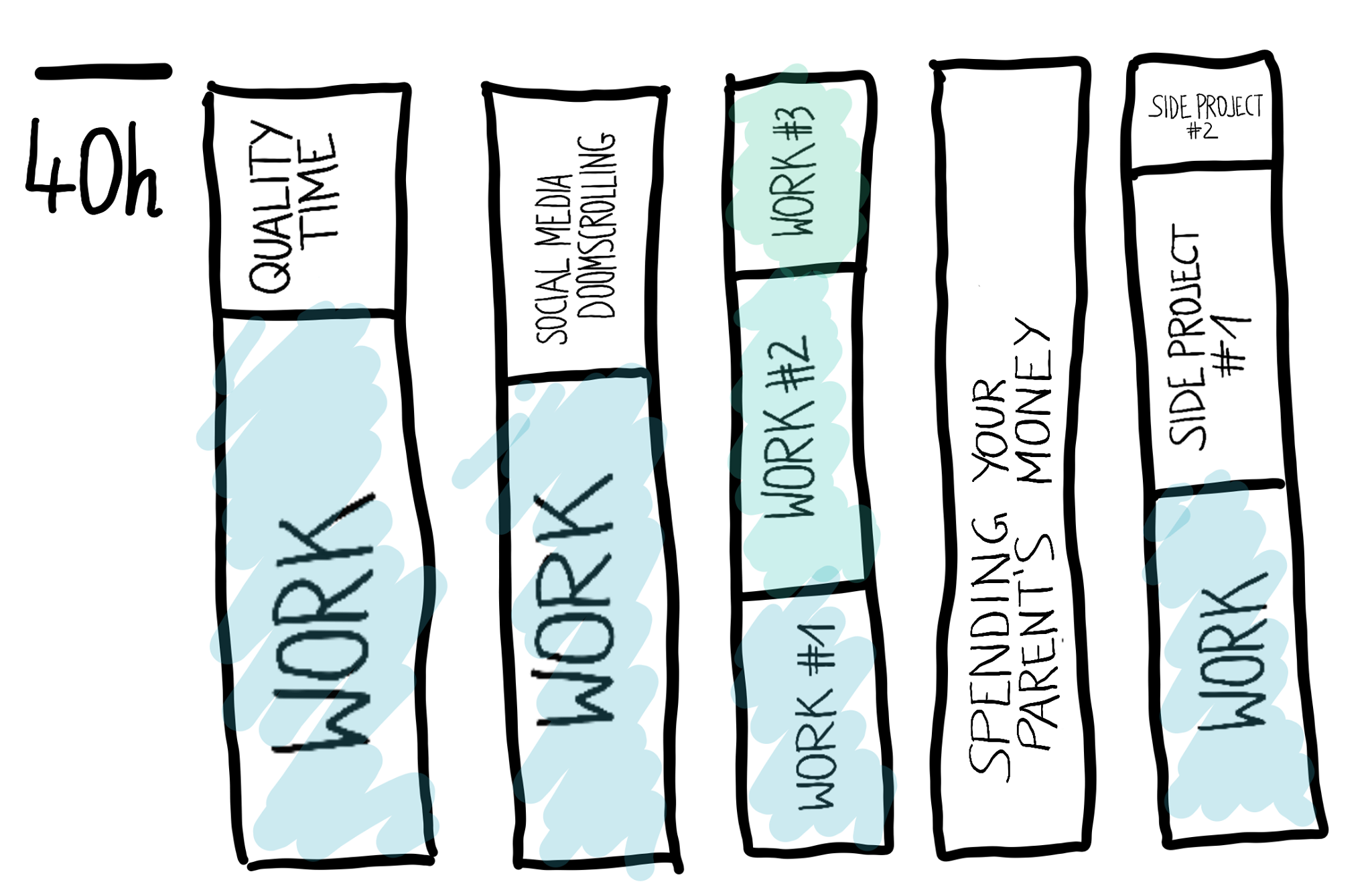Part-Time Perks
Some maybe not-so-obvious reasons for saying ‘no’ to a 40h working contract
More Time To Do What You Want

Obviously, voluntarily not having a full-time job can mean quite a couple of different things. Examples of voluntary ‘no full-time job’ realities Although all of these life choices translate into very different realities, I would argue that all of them result in more time for ‘doing what you want’ compared to a full-time employment1. It’s the most obvious if you spend a bigger part of your time on things generally considered as enjoyable (Quality time with friends and family, Spending your parent’s money, Social Media Doomscrolling2), but I’d say also as a freelancer (aka having multiple ‘works’) or as a person running ‘side projects’ you have more freedom to do what you want (e.g. have one or two projects to feed you and one project that you particularly enjoy).
Risk Diversification
In the case of the freelancer this is evident (i.e. if one of your customers goes bankrupt that’s bad, if your employer goes bankrupt that’s very bad). For the other examples it’s less of an income related risk diversification but more of an emotional risk diversification. People that invest comparatively more time into relationships or side projects have more sources to derive meaning/purpose from, making it easier to cope with a potential job loss. Admittedly, not sure if that holds also for people spending their additional free time on social media.
Spillover Effects
Let’s start with a definition:
Spillover Effect: An economic event in one context that occurs because of something else in a seemingly unrelated context.3
And let’s continue with a cheesy startup example:
I decided to take a calligraphy class to learn how to [learn calligraphy]. I learned about serif and sans-serif typefaces, about varying the space between different letter combinations, about what makes great typography great. It was beautiful. Historical. Artistically subtle in a way that science can't capture. And I found it fascinating. None of this had any hope of any practical application in my life. But 10 years later, when we were designing the first Macintosh computer, it all came back to me. And we designed it all into the Mac. It was the first computer with beautiful typography. If I had never dropped in on that single course in college, the Mac would never have multiple typefaces or proportionally spaced fonts. And since Windows just copied the Mac, it's likely that no personal computer would have them. 4
And an example from science to close:
While you are leaning things you need to think about them and examine them from many sides. By connecting them in many ways with what you already know.... you can later retrieve them in unusual situations. (…) The evidence is overwhelming that steps that transform a field often come from outsiders. In archaeology, carbon dating came from physics. The first airplane was built by the Wright brothers who were bicycle experts.5
Summarizing, both examples indicate, that good or novel ideas occur often when you connect two previously unrelated dots in your brain. Having multiple different occupations and/or more time to invest in non-work related hobbies or passions can thus increase the chances for producing such ideas.
Flexibility
Not working on an 8-to-5 schedule allows for responsiveness to other people’s schedules (children, family, friends, partner etc.) and thus makes it easier to integrate more and potentially different people in your life. Also, you can avoid crowds (e.g. shopping during the week is much more relaxing than on Saturdays) and adjust to weather forecasts (i.e. going for a walk on a sunny Tuesday). Needless to say that full-time employments do have quite some benefits as well (e.g. security, increase in domain knowledge, potentially higher income) and they are still the most common and most preferred type of employment in all European countries. Nevertheless, as we are witnessing a long-term trend of GDP growth (and a substantial level of GDP per capita is kind of a prerequisite for going part-time) I believe, more people will want to make use of these part-time perks. Given additional trends like the rise of the creator economy, more focus on work-life balance, increasing overall productivity and the current shift towards remote work, I expect to see a significant increase in voluntary part-time work within the next century.6
If you liked what you read, you might also enjoy my bi-weekly newsletter that delivers inspiration from all over the internet to the notoriously curious.
If you didn’t like what you read, consider shooting me an email to bring on the discussion.
Footnotes
- The transition between ‘work’ and ‘side project’ is a fluid one. The way I see it here, is that a side project is something that (1) does not take up the majority of your time and (2) is not (yet) a relevant source of income. Also the distinction of ‘quality time’ and ‘work’ is not always a clear one, e.g. being a stay-at-home parent is definitely (unpaid) work but hopefully also increases quality time. Potentially, there exist also parents classifying their children as side projects. Not sure if that’s a good thing though.
- You might not consider this as enjoyable, but your brain does. New information triggers the dopamin fuel reward in your brain the same way food, drugs or money do. Kobayashi, Hsu (2019): Common neural code for reward and information value
- Wikipedia Definition of Spillover Effects
- Steve Jobs on Taking a Calligraphy Class
- Dr. Richard Hamming: A Stroke of Genius
- Part-time work here does not include freelancers etc. I would also expect to see more people being self-employed, contractors, freelancers etc.